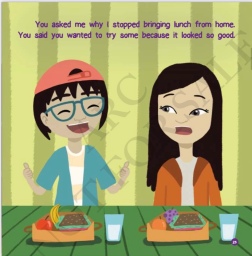

This 62 page early elementary story is told from two perspectives, you flip the book to read each parallel story from two points of view, the refugee children’s and the children welcoming them. Overall, I feel it is very well-intentioned and gets a lot right, but I found myself not feeling comfortable with some of the messaging regarding the visibly Muslim character included.

I love that there are characters of all skin tones both welcoming the refugees and the refugees themselves. And I love the vague universalness that binds all the refugees together being expressed: that they love their home, they had to flee, the journey was dangerous, they left everything behind, etc..

I also love the warmth and genuine compassion that comes from the welcoming children. They are reassuring, open, and seem to truly want to provide confidence to their new classmates. The simple text really conveys a lot of emotion albeit very idyllic, that provides ways that readers in similar situations can also mimic when welcoming anyone new.

On one of the two story sides a map is included showing that the refugee kids come from all over the world, the side that did not have the map I worry might confuse young readers. They might not realize that the five children do not all come from the same country. There should be a map on both sides, ideally.

The illustrations that show how the welcoming kids understand the refugee stories is clever in the showing of their understanding. The images are similar, but the different style is a great emphasis on how we process from our point of reference facts that others have lived.

The concept of a new kid finding everything so different and not fitting in, is a great concept to explore in terms of clothing and food and language, but for some reason I didn’t like how the girl in hijab was presented. I’m ok that she took off her hijab to fit in, and that her classmates encouraged her to be herself, and put it back on, but the text is too over reaching, to an erroneous end.

It says on one page, “No one looked like me, but most people smiled.” Really, NO ONE? No other Muslims exist in your new home? It then says, “I was afraid to wear my real clothes to school. The other kids didn’t dress like me.” In the illustration her clothes are EXACTLY THE SAME, the only thing that changes is she has a scarf on. Hijabs are a religious article of clothing, they are not unique or country specific. And what does real clothing even mean?

I also didn’t like the text reading, “This is my journey’s end.” That seems to imply that you leave the horrors behind, you build bridges, this is your home now, and that is it. This is a children’s book, the message should be that there is so much more to you and to your life, and you will find welcoming people and be the one welcoming in the future. I don’t like that it seems to carry the weight of finality to a person’s story. People, all of us, are more than just a label.
